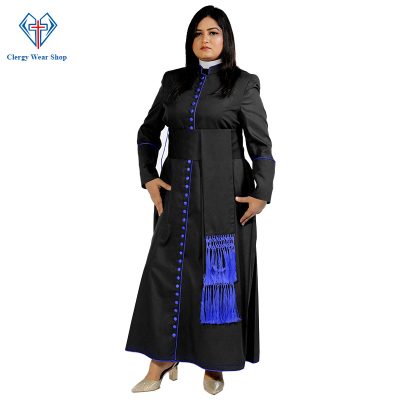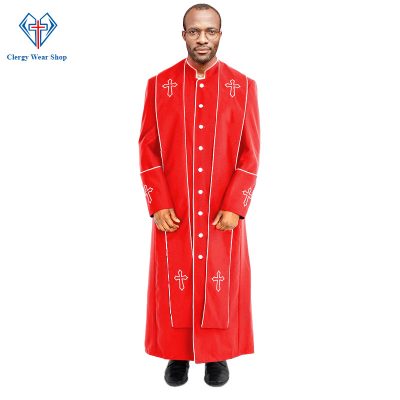Pastors Clothing: Tradition, Modernity, and Trends
Pastors clothing is a significant element in religious traditions, symbolizing dedication, authority, and the spiritual leadership of clergy members. This attire not only serves functional purposes but also carries deep symbolic meanings, reflecting the values and practices of various religious communities. In this comprehensive guide, we will explore the history, significance, and modern trends in Pastors Clothing, with a focus on distinctive styles for both men and women in pastoral roles.
The Historical Significance of Pastors Clothing
Early Christian Era
In the early Christian church, pastors and other clergy members wore garments similar to those of the general population but with specific adaptations to signify their religious roles. Simple tunics and robes were the norm, emphasizing humility, simplicity, and devotion.
Medieval Period
During the medieval period, pastors clothing became more elaborate, especially for high-ranking clergy. Richly decorated vestments, such as chasubles and copes, were common. These garments symbolized the church's growing influence and the spiritual authority of its leaders.
Reformation
The Protestant Reformation brought significant changes to pastors clothing. Reformers advocated for simpler, more modest clothing to contrast with the opulence of the Catholic Church. Black became the standard color for pastoral garments, symbolizing humility and a break from the past.
Modern Era
In contemporary times, pastors clothing has evolved to incorporate both tradition and modernity. While maintaining symbolic elements of humility and service, modern pastoral attire also embraces new materials, styles, and cultural influences.
Pastors Clothing for Men
Men's pastors clothing combines tradition, professionalism, and comfort. These garments are designed to reflect the dignity and authority of their religious roles.
The Clerical Suit
The clerical suit is a staple for male pastors. Typically black or dark in color, the suit includes a tailored jacket, trousers, and a clerical shirt with a Roman collar. This Pastors Clothing for Men symbolizes professionalism, dignity, and the pastoral role's serious nature.
The Cassock
The cassock is a long, close-fitting robe worn by pastors in many Christian denominations. It is usually black but can be red or purple for higher-ranking clergy. The cassock represents a commitment to religious life and is a visible sign of church leadership.
The Clerical Collar
The Roman collar, a white band worn around the neck, is an essential part of pastors clothing. It signifies the wearer's religious authority and dedication to their faith. The collar is often paired with a black clerical shirt.
The Stole
The stole is a long, narrow strip of cloth worn around the neck, often adorned with religious symbols. It signifies the authority to perform sacraments and is an important part of liturgical attire.
Liturgical Vestments
During services, male pastors may wear additional liturgical vestments such as the chasuble and alb. These garments are rich in symbolism, representing the sacred nature of their duties.
Pastors Clothing for Women
Women's pastors clothing reflects their esteemed position in spiritual leadership, combining tradition with modern sensibilities.
The Clerical Blouse and Skirt/Trousers
Women in pastoral roles often wear a clerical blouse paired with a skirt or trousers. The blouse, designed to resemble the traditional clerical shirt, features a Roman collar or a tab collar. This attire is both professional and comfortable, suitable for various church activities.
The Clerical Dress
In some denominations, female pastors wear a clerical dress, which provides a dignified and cohesive appearance. The dress often features a clerical collar and can be adorned with subtle religious symbols.
The Clerical Collar
Like their male counterparts, female pastors wear the clerical collar as a symbol of their religious commitment. The collar is integrated into blouses, dresses, or shirts, maintaining its symbolic importance.
Liturgical Vestments
During services, female pastors may wear liturgical vestments such as the alb and stole. These garments are designed to reflect the solemnity and sacredness of religious ceremonies.
The Cape or Cloak
In some traditions, female pastors wear capes or cloaks, adding a layer of formality and dignity. These garments are often adorned with religious symbols and provide an additional element of distinction.
Modern Trends and Innovations in Pastors Clothing
Eco-Friendly Materials
With an increasing focus on environmental stewardship, many manufacturers are using eco-friendly materials for pastors clothing. Organic cotton, bamboo, and recycled fabrics are becoming popular choices, aligning with the values of sustainability and respect for creation.
Inclusive Sizing
Inclusivity is a key trend in modern pastors clothing. Manufacturers are offering a wide range of sizes to accommodate clergy of all body types, ensuring that everyone can find garments that fit comfortably and respectfully.
Gender-Neutral Options
Recognizing diverse identities within religious communities, some manufacturers create gender-neutral Pastors Clothing for Women. These garments are designed to be worn by anyone, regardless of gender, promoting inclusivity and equality.
Customization
Customization allows pastors to tailor their garments to their personal preferences and needs. Options include custom embroidery, monograms, and tailored fits, providing a personalized touch to traditional attire.
Modern Styles
While traditional styles remain popular, modern styles are also emerging. Contemporary pastors clothing may incorporate elements of current fashion trends, such as slimmer fits, modern fabrics, and innovative designs, while still maintaining the dignity and symbolism of traditional garments.
New Information and Insights
Technological Integration
Some modern pastors' clothing integrates technology, such as moisture-wicking fabrics and UV protection, enhancing comfort and functionality. These innovations are particularly beneficial for clergy who spend long hours in their garments.
Ethical Manufacturing
There is a growing emphasis on ethical manufacturing practices, ensuring fair labor conditions and environmentally sustainable processes in producing pastors clothing. This shift reflects a broader commitment to social justice and stewardship.
Enhanced Durability
Innovations in fabric technology have led to more durable pastoral garments that withstand frequent use and washing, maintaining their appearance and functionality over time.
Interfaith Influence
Interfaith dialogues have influenced pastors' clothing, with designs incorporating elements from various religious traditions. This cross-cultural exchange fosters unity and respect within and between religious communities.
FAQs About Pastors Clothing
1. Why is pastors clothing important?
Pastors clothing symbolizes religious commitment, denotes authority within the religious community, and distinguishes pastors from laypeople. It provides a dignified and professional appearance essential for spiritual leadership.
2. Can pastors wear casual clothes?
Outside of religious services and official duties, pastors often wear casual clothes. However, during services and official functions, they typically wear formal clergy attire to signify their role and responsibilities.
3. How does pastors clothing differ for men and women?
While many components are similar, pastors clothing for men and women is tailored differently to fit their bodies. Women’s attire includes tailored blouses, dresses, and the option to wear skirts or trousers, while men’s attire features tailored jackets, shirts, and trousers.
4. How has pastors' clothing evolved?
Pastors' clothing has evolved from simple tunics in early Christianity to elaborate medieval vestments and simplified Reformation garments, continually adapting to religious practices and societal norms.
5. What materials are used in pastors' clothing? Materials include cotton, wool, silk, and synthetic fabrics. Recently, eco-friendly materials like organic cotton and recycled fabrics have become popular.
6. Can pastors' clothing be customized? Yes, many manufacturers offer customization options, allowing pastors to choose custom fits, embroidery, monograms, and other personalized elements.
7. Are there gender-neutral pastoral garments? Yes, some manufacturers create gender-neutral pastors clothing, promoting inclusivity and equality within religious communities.
8. How do different denominations influence pastors' clothing? Different denominations have unique traditions and guidelines. For example, Catholic pastors wear elaborate vestments, while Protestant pastors often wear simpler black clerical suits.
9. What role does pastoral clothing play in non-Christian religions? Pastors' clothing in non-Christian religions, like the kittel in Judaism and the thobe in Islam, symbolizes religious devotion and authority.
10. What are modern trends in pastors' clothing? Modern trends include the use of eco-friendly materials, inclusive sizing, gender-neutral options, customization, modern styles, technological integration, ethical manufacturing, enhanced durability, and interfaith influence.
 |
| Pastors Clothing for Women |
Conclusion
Pastors clothing is a rich and evolving tradition that reflects the diversity of religious practices and cultural influences. These garments symbolize faith, authority, and devotion, providing pastors with a dignified and professional appearance. Whether worn by men or women, this attire continues to adapt, embracing new trends and technologies while maintaining its significance and dignity in religious life.




Comments
Post a Comment